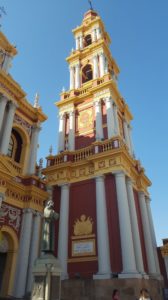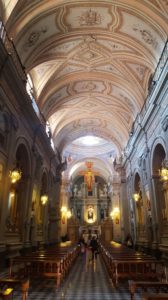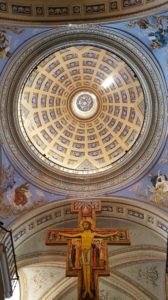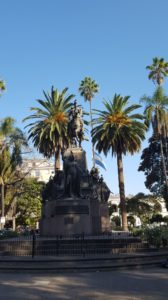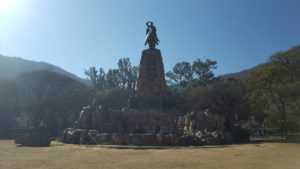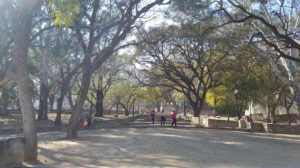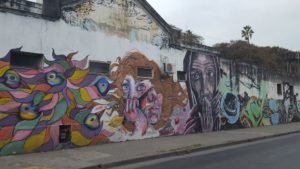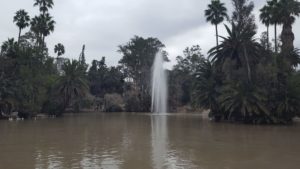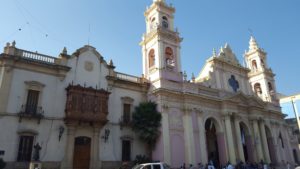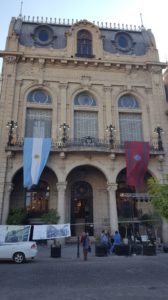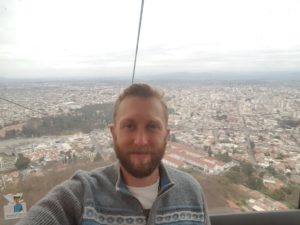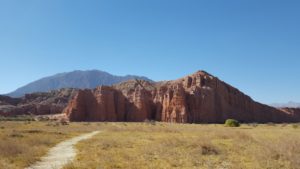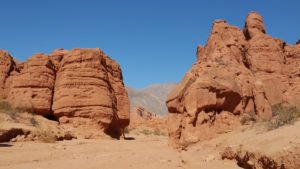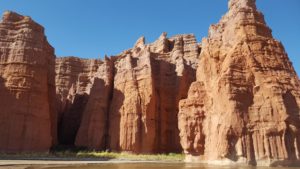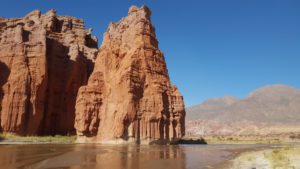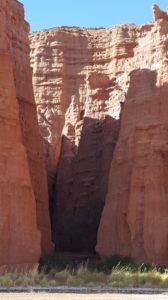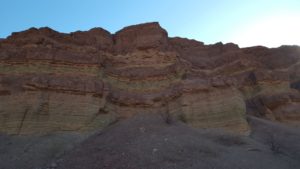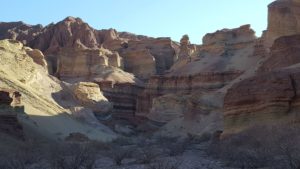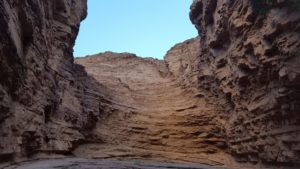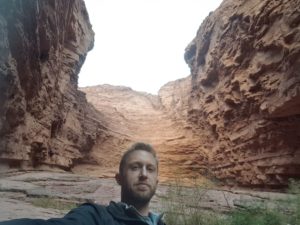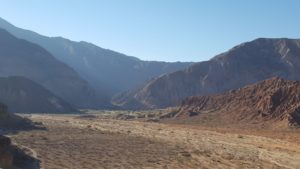It was a long, arduous trip from San Pedro to Salta. To compensate, the scenery from the red rock desert of the Atacama region through a passageway high in the Andes was magnificent. The border crossing into Argentina was a basically a rubberstamp and running your bags through a scanner process, albeit slow. The ride from the Andes back down into the flatlands near Salta was equally stunning. I only wished I was on a tour bus that stopped at lookouts, but instead had to enjoy the views from inside the moving bus.
As is normal in South America, the bus ride took longer than expected, and I didn’t arrive in Salta until 9pm. I decided to hoof it the 20 or so blocks to my hostel. We lost an hour during the bus ride, changing into the time zone one hour later than NYC time, so it was actually 10:15pm when I arrived at Ferienhaus Hostel.
There was no one to hang out with at the hostel, so I set out to explore the town and find dinner.
Salta is city of about 700,000 in the far northwest of Argentina. It lies in a valley at the foot of the Andes, which provide a lovely backdrop of the city to the west. It has pleasant, comfortable weather. Sunny and warm during the day, and cool but not cold during the night. Argentina has few cities with distinct Spanish colonial features common in the rest of South America, but Salta is known as being the country’s most Spanish city. It is the northernmost point in Argentina’s world-famous wine region. Vast grape fields stretching east from the Andean foothills down to the river valley begin appearing to the south of the city, and stretch all the way down to Mendoza.
I found myself at a café with patio seating facing the main plaza. I ordered a chicken sandwich and a beer, and I got my first example of how they do food in Argentina: Big. The waiter brought me a stein containing about 1.5 liters of beer. The sandwich was gigantic. Easily large enough for three people. It had loads of pulled roasted chicken, and the chefs must have used a minimum of half of a bird on this one sandwich. It was excessive, but I wasn’t complaining. After battling with the sandwich for 30 minutes, I only managed to get about 2/3 of the way through it, and gave the rest to a beggar.
I wandered around town until midnight, at which point my stuffed gut was too much to continue to bear. I returned home and passed out.
After a leisurely breakfast the next morning, I went to the main plaza for a free walking tour of Salta. On the tour was Scott (South Africa) and Sarah (Germany) with whom I had went on the mine tour in Potosi. It was just us three plus two other girls from Australia on the tour, plus our colorful guide Rodolfo. It was a typical walking tour, stopping at various churches, government buildings, monuments, and a convent.
Afterwards, Scott, Sarah, and I went out for lunch at restaurant recommended by Rodolfo. I had the menu del día: two carne empanadas to start, a milanesa (breaded fish baked and covered with salsa and cheese, and a chocolate mousse for dessert. As is typical with lunch in Argentina, we were served teeming cups of red wine with the menu.
After lunch, I broke off from Scott and Sarah to run some errands. It was my first day in Argentina, and I was shocked to find almost all the businesses closed at 2:30pm on a Saturday afternoon. The city, even around the central plaza, was like a ghost town. I wondered, “How do these businesses make any money if everything is closed at midday on what’s probably the highest revenue day of the week?” The only thing open were a few cafes with people dining on the patios near the park. I asked a waiter why everything was closed, and he explained that it was ‘hora de siesta’.
Similar to Spain, in most cities in Argentina (not Buenos Aires) everything shuts down from 1pm to 5pm every day for people to have lunch and take a nap. People generally work from 9am-1pm, take the midday siesta break, and then resume from 5pm-9pm. The start times are very flexible, mind you. Then they dine at 10pm or later. Owing to strong Spanish and Italian heritage, everything runs on a generally relaxed, laid back schedule with a ‘devil may care’ attitude in Argentina.
“Welp, who am I to go against the cultural mores of a foreign land I’m visiting,” I thought, and headed home, slightly fatigued from much walking and the lunchtime wine, to take my own siesta.
After my siesta, I went out to run my errands, but ran into live music on the plaza. I wound up just getting a beer and watching the concert.

In the evening, I met John, a quirky Asian guy from the UK who was a volunteer at the hostel. We had a couple of beers in the living room while waiting to head out to dinner. By 8pm I was hungry, but John advised me we’d have to wait a couple of hours yet, as many restaurants don’t even open up until 8:30-9pm and diners don’t normally arrive until around 10pm.
We knocked back another couple, and finally headed out to Viracocha, another restaurant recommended by Rodolfo, at 9:30pm. This was a nice, gourmet restaurant, and I tried the sopa de mani (peanut soup) and lomito en salsa de Malbec (tenderloin in a reduced Malbec wine sauce), two specialties of northwest Argentina, with a couple glasses of cabernet. It was delicious, although more expensive than the prices of gourmet meals in Bolivia to which I had grown accustomed, coming out to a bit over $30.
After dinner, I was a bit toasted and wanted to hit the town. Unfortunately, John was working the nightshift and had to be back at the hostel at midnight. We stopped for one more drink. John recommended bars for me to go head to, but I wasn’t feeling going out solo tonight. I went back to the hostel with John in hopes of finding another compadre, but the hostel was dead and I wound up just calling it a night.
The next day, I headed out to run the errands I failed to do in the afternoon the prior day. The city was again like a ghost town, but even more abandoned on Sunday than during siesta hour. Every storefront shuttered, no cars or traffic about, just a couple old people reading the newspaper and sipping mate in the plaza. It’s fairly common for everything to be closed on Sunday in Latin America, but usually supermarkets and corner stores are open. But here, nothing was open. I walked around for 20 minutes looking for somewhere to buy some groceries before realizing it was futile. “Dang, they really have one heck of a cultural ‘I don’t give a fuck’ attitude in Argentina. Admirable, if inconvenient. Better keep this in mind for the following Sundays,” I thought to myself on the way back to the hostel.
Luckily, I had some rice, eggs, avocado, and a can of sardines socked away that got me through the day. I spent all afternoon playing poker. I had no significant results to speak of, but finished slightly in the green. Nothing but heartbreak down the stretch in my tournaments. Oh well, something’s gonna give soon.
The morning I spent doing administrative stuff like paying bills and researching the impending Bitcoin hard fork.
At noon, I headed out and found the trendy Café Bixi where I stopped for lunch and a cup of joe. I guess I hadn’t quite gotten a hang of how things work in Argentina yet, because I absentmindedly ordered a burger and received a monstrosity about 8” in diameter made with probably 2/3 of a pound of beef. No wonder they need siestas… wine and beer at lunch, monstrous meals… it’s like they’re trying to induce a food coma. I ate half the burger and took the rest to go.
I wandered around the city before arriving at Cerro San Bernardo and took a telefericó ride to the top. There was a small park, a chapel, some vendors, and a lookout at the top, but nothing too impressive. The day was overcast, not inspiring the grandest view. I only spent about 30 minutes at the top before riding back down.
I spent the late afternoon writing in Café Logro for a couple of hours, before wandering back to the hostel at dusk. There I made a big plate of sautéed broccoli and carrots to try and get some vegetables into my diet and ate it with my leftover hamburger.
I spent the rest of the evening chatting with a group of three Argentinos from Rosario who were towards the end of a trip touring South America on bicycles. We shared stories of exploits and adventures during our journeys.
The next day it was time to move on. I headed to the bus station at noon, and got a 1pm bus to Cafayate. The bus ride was once again splendid, traveling through scenic red rock desert into beautiful wine country landscapes. I arrived at 3:30pm.
As I was gathering my bags at the bus station, an Argentine named Diego handed me a flier to a hostel and offered me a ride. I didn’t have anywhere booked, so said why not, jumped in his pickup, and he carted me to Backpacker’s Hostel. I checked in, dropped my bags, got a map and information from the girl working at the hostel and headed out to explore the town.
I didn’t know much about Cafayate before I came. I had heard it’s an idyllic, small town smack dab in the heart of wine country. That it is. The entire town is about 12 blocks by 12 blocks. With tan dusty dirt roads, gauchos riding through on horseback, and not a building in town more than two-stories high, it certainly has the feeling of an unspoiled out-of-the-way pueblo of old. Yet, it’s not entirely old-world as it has wealth from the numerous wineries and bodegas around town. Simply put, it’s a quaint place where tourists pass time carefree while indulging in the ample wines produced in the region.
I stopped in Bodega Nanni to do a wine tasting. Bodegas are wine cellars with accompanying wine bars. They generally work with a specific vineyard and get the wine direct. They offer daily tastings and sell wine by the bottle and case at slightly discounted prices. Unfortunately, the guy behind the bar informed they do their daily tasting at 10:30am. “WTF who does a wine tasting in the morning?” I thought. The bartender took mercy on me, and poured me a few different cup-sized samples. He apologized that he wasn’t a sommelier, so couldn’t give me as much information as during the tasting, but did his best to explain the features of the different wines and it more than sufficient for my noob ass. At the end, I asked what I owed, and he told me not to worry about it.
I had a nice buzz brewing, and tried to stop at another couple of bodegas, but they were both closed (siesta hour). Instead, I settled for a glass of Malbec at a café on the plaza.
I hung out at the hostel until 9pm, then headed out to Bad Brothers Wine Experience. This place was legit. Gourmet food, fine wine, and engaging staff. I went for a three-course meal, starting with two chorizo empanadas with a spicy mayo sauce, short rib in a tangy fruit and Malbec sauce with some kick, and finally a lava cake with homemade mint ice cream. I began with a glass of Torrontes wine (a white wine that’s big in the region) on the recommendation of the waitress. She told me I have to drink Torrontes if in Cafayate. Not too sweet, not too dry, just right. Then had a glass of Malbec with dinner and another of Cabernet for good measure. Everything was fantastic. I couldn’t recommend this place more highly.
The next morning, I spent hanging around the hostel, slightly hungover. In the afternoon, I headed out to explore town more, and stopped at the local market with loads of fresh farmed produce. I also had lunch at La Casa de Empanadas, a staple of Cafayate. If you haven’t noticed yet, empanadas are a thing in Argentina. They can be bought at almost every corner store, café, restaurant, bakery, and people on the street. The best ones are baked, not fried, and filled with mixtures of high quality ingredients and spices. At La Casa de Empanadas top quality, gourmet empanadas can be bought for about 15 Pesos, or about $0.90, each. Four of these, with a little homemade hot sauce, and I was a happy camper.
I booked an afternoon tour by van to see several sights around Cafayate. The tour traveled north of Cafayate and stopped at several sites of natural beauty including Los Castillos, La Vencha, Garganta del Diablo, El Antiteatro, and La Quebrada de las Conchas. Several of the sights were quite impressive, especially the Garganta and the Ampiteatro, massive naturally carved geological wonders.



The tour returned at 7:30pm, and I stopped at Restaurante La Estancia on the main plaza. I had a Cazuela de Llama, a thick, spicy stew of shredded llama and a glass of Malbec. It was definitely good, but nothing like Bad Brothers. I wanted to mix it up and try different restaurants, but probably should have just went back to Bad Brothers after the great time I’d had the night before.
On the way home I got ice cream at Heladaría Miranada, another staple of town, then laid in bed reading. After a while, I could see my breath in the light of my Kindle, and decided to snuggle up and slumber.
The next morning, I walked to the bus station to look at the schedule. I wanted to head south to Mendoza, but learned there was not a direct bus to Mendoza. All the buses head to San Miguel de Tucumán first, then I’d have to get another bus to Mendoza from there. I’d never even heard of Tucumán until now. I bought a ticket for the next bus, leaving at 2pm.
I spent the day hanging out in the plaza, mostly reading, and walking around town. I stopped at La Casa de Empanadas again, and filled up with more Heladaría Miranda before catching my bus. Cafayate was another place I’d love to have passed a sleepy week doing little, just relaxing and enjoying the slow pace of life in northern Argentina. Instead, schedule not permitting, I had to keep rambling.


